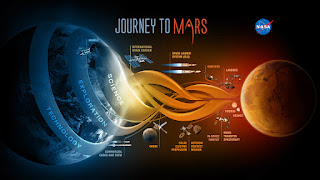CASE 456 - Life on mars
Mars is the fourth planet from the Sun and the second-smallest planet in the Solar System, after Mercury. Named after the Roman god of war, it is often referred to as the "Red Planet" because the iron oxide prevalent on its surface gives it a reddish appearance. Mars is a terrestrial planet with a thin atmosphere, having surface features reminiscent both of the impact craters of the Moon and the valleys, deserts, and polar ice caps of Earth. The rotational period and seasonal cycles of Mars are likewise similar to those of Earth, as is the tilt that produces the seasons. Mars is the site of Olympus Mons, the largest volcano and second-highest known mountain in the Solar System, and of Valles Marineris, one of the largest canyons in the Solar System. The smooth Borealis basin in the northern hemisphere covers 40% of the planet and may be a giant impact feature. Mars has two moons, Phobos and Deimos, which are small and irregularly shaped. These may be captured asteroids, similar to 5261 Eureka, a Mars trojan.
There are ongoing investigations assessing the past habitability potential of Mars, as well as the possibility of extant life. Future astrobiology missions are planned, including the Mars 2020 and ExoMars rovers. Liquid water cannot exist on the surface of Mars due to low atmospheric pressure, which is about 6⁄1000 that of the Earth's, except at the lowest elevations for short periods. The two polar ice caps appear to be made largely of water. The volume of water ice in the south polar ice cap, if melted, would be sufficient to cover the entire planetary surface to a depth of 11 meters (36 ft). On November 22, 2016, NASA reported finding a large amount of underground ice in the Utopia Planitia region of Mars. The volume of water detected has been estimated to be equivalent to the volume of water in Lake Superior.
Mars can easily be seen from Earth with the naked eye on certain evenings, as can its reddish coloring. Its apparent magnitude reaches −2.91, which is surpassed only by Jupiter, Venus, the Moon, and the Sun. Optical ground-based telescopes are typically limited to resolving features about 300 kilometers (190 mi) across when Earth and Mars are closest because of Earth's atmosphere. Using information about Mars' mass, size and the structure of its gravity field, scientists have determined the different densities of Mars' interior structure. Mars' core has twice the concentration of lighter elements than the Earth, and is probably made from iron, nickel and sulphur (a lighter element) and is partially fluid. The mantle and crust are both made from silica rich rocks. Mars crust is much thicker than Earth, between 50 - 125 km deep (compared to Earth's average of 40 km.
Elon Musk plans to get 1 million people to Mars. At a conference in Mexico today (Sept. 27), the SpaceX founder and CEO unveiled the company's Interplanetary Transport System (ITS), which will combine the most powerful rocket ever built with a spaceship designed to carry at least 100 people to the Red Planet per flight. If all goes according to plan, the reusable ITS will help humanity establish a permanent, self-sustaining colony on the Red Planet within the next 50 to 100 years, Musk said at the International Astronautical Congress in Guadalajara.
"What I really want to do here is to make Mars seem possible — make it seem as though it's something that we could do in our lifetimes, and that you can go, but living there is the easy part<" he said.
Elon musk / CEO and founder of Tesla motors and SpaceX
There would still be many questions that would need asking and situations would need resolving before we even stepped foot on mars, such as temperature day/night, time and timezones, resources humans need to live and build such as water, food, metals.
The possibility of life on Mars is a subject of significant interest to astrobiology due to the planet's proximity and similarities to Earth. To date no proof has been found of past or present life on Mars. However, cumulative evidence is now building that the ancient surface environment of Mars had liquid water and may have been habitable for microorganisms. The existence of habitable conditions does not necessarily indicate the presence of life. Scientific searches for evidence of life began in the 19th century, and they continue today via telescopic investigations and landed missions. While early work focused on phenomenology and bordered on fantasy, modern scientific inquiry has emphasized the search for water, chemical biosignatures in the soil and rocks at the planet's surface, and biomarker gases in the atmosphere. On November 22, 2016, NASA reported finding a large amount of underground ice in the Utopia Planitia region of Mars. The volume of water detected has been estimated to be equivalent to the volume of water in Lake Superior. Mars is of particular interest for the study of the origins of life because of its similarity to the early Earth. This is especially so since Mars has a cold climate, and lacks plate tectonics or continental drift, so it has remained almost unchanged since the end of the Hesperian period. At least two thirds of Mars's surface is more than 3.5 billion years old, and Mars may thus hold the best record of the prebiotic conditions leading to abiogenesis, even if life does not or has never existed there.
On January 24, 2014, NASA reported that the Curiosity and Opportunity rovers started searching for evidence of past life, including a biosphere based on autotrophic, chemotrophic, or chemolithoautotrophic microorganisms, as well as ancient water, including fluvio-lacustrine environments (plains related to ancient rivers or lakes) that may have been habitable. The search for evidence of habitability, taphonomy (related to fossils), and organic carbon on the planet Mars is now a primary NASA objective.




No comments:
Post a Comment